Bike Perfect Verdict
Canyon manages to combine excellent control and composure with a lively and fun ride quality that is at home no matter what the trail
Pros
- +
Flat-out-fast geometry
- +
Impeccable suspension balance
- +
Excellent high-control kit
- +
The quietly damped ride feel
- +
Forgiving yet seriously fast
- +
Practical detailing
- +
Lighter RockShox options
Cons
- -
Smooth rather than sharp ride feel
- -
Rear brake pad rattle
- -
Direct sell not shop supplied
- -
If possible go for the CF9 for lighter weight
Why trust BikePerfect
Canyon is one of the last brands to introduce an all-round trail bike on bigger 29er wheels, but the ground-up redesign of the Spectral family is frankly brilliant, however you like your modern trail/enduro mountain biking. The price is also excellent but it means a bike in a box not from a shop.
Keep reading for more on this fantastic bike, and for more bikes on similar lines, check our guides to best trail bike and best enduro mountain bike.
Design and geometry
The new Spectral carries over the overall four-bar rear, downtube mounted shock layout of the 27.5in wheeled Spectral (which still stays in the line) but there’s a lot of extra practical detail and a totally new set of angles and dimensions.
Structural aesthetics are particularly good with the chunky head tube, down tube and massive chainstays underlining a purposeful look. The top tube/extended seat tube junction, linkage and projecting seat stays create a very pleasing set of reflected and bisected angles, too, and it comes in two-tone gloss/matt black or the lime and black ‘X-Ray’ colorway here in four different sizes.
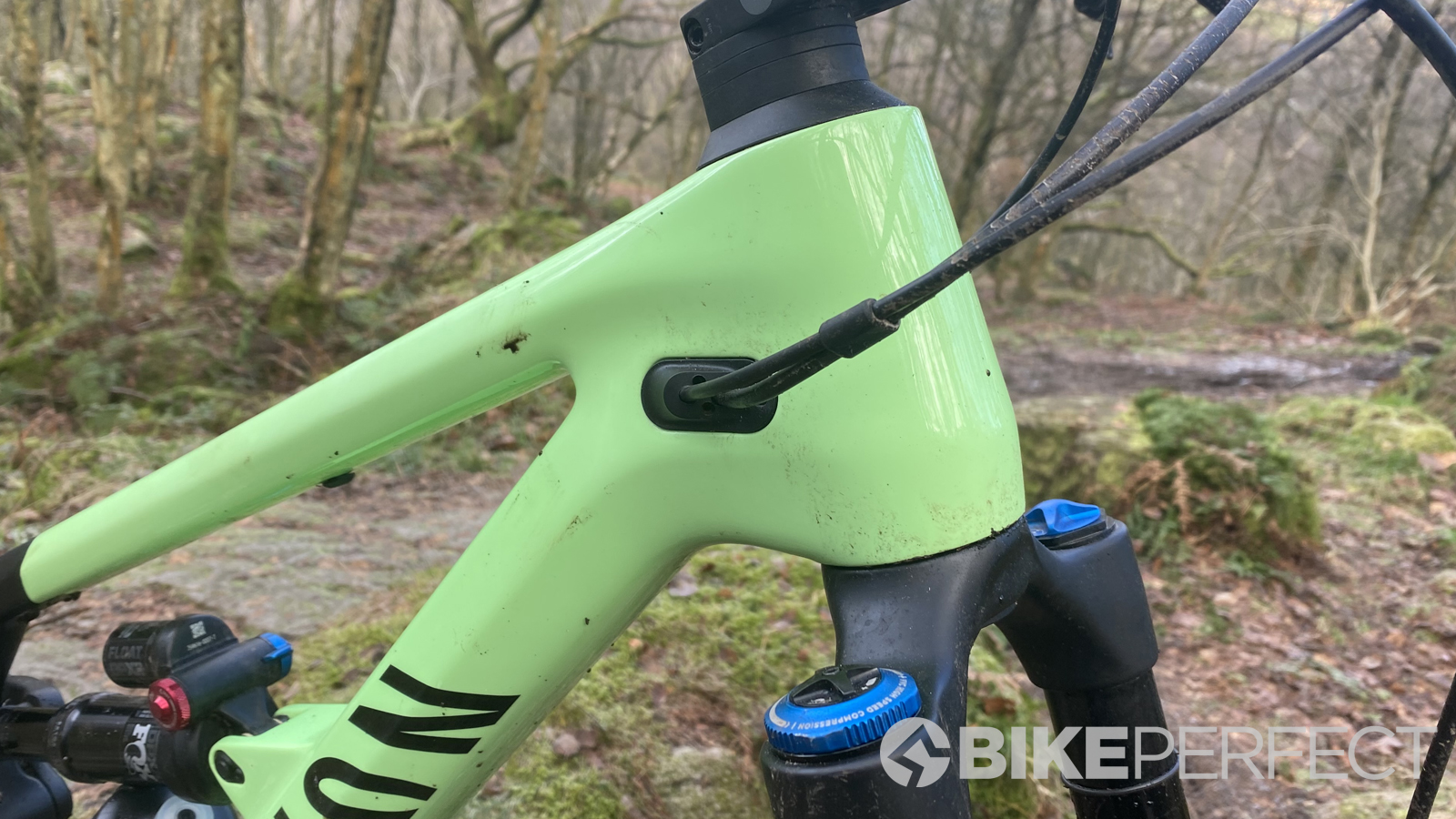
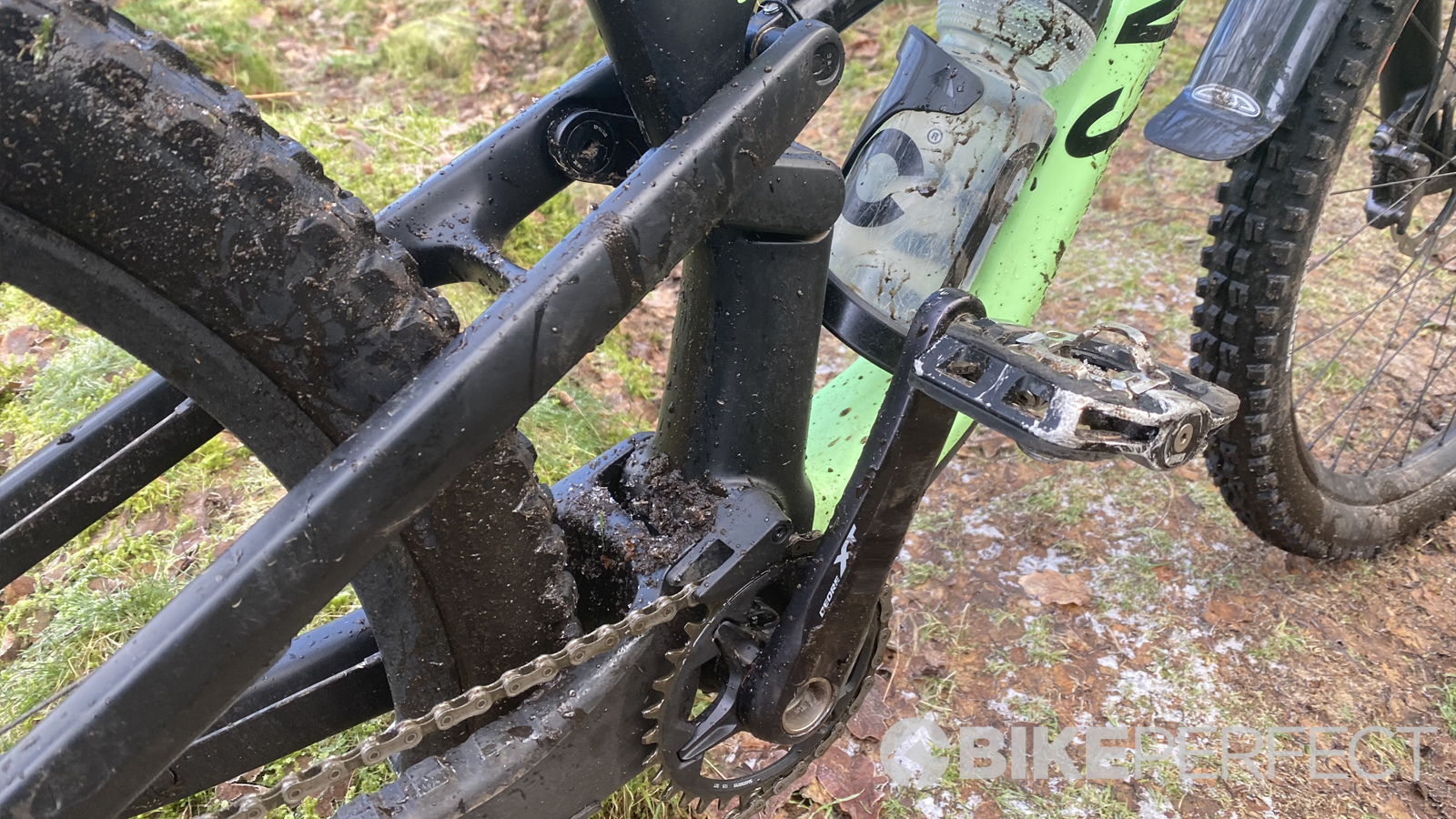

Internal control routing is now fully piped from the neat entry and exit caps and the bottom bracket is threaded rather than press-fit which makes replacing worn-out bits much easier further down the line. You can fit an optional ISCG mount for a full or partial chain guide and it comes with a small chain keeper top block fitted as standard. The shock bolts sit in replaceable inserts in case you round them out which is a feature borrowed from the Sender DH frame. The rear mount also includes a flip-chip to change angles by half a degree and ride height by 8mm. All pivots are now double sealed and the pivot bolts can be accessed from the offside so there’s nothing in the way when checking/tightening. The rear mech bolts onto SRAM’s new UDH (Universal Derailleur Hanger) and the rear axle uses a ‘Quixle’ pop-out lever so you only need an Allen key for the fork. There’s still just enough room for a standard bottle in a side release cage under the shock and a bolt mount for a frame strap under the top tube. The downtube gets extra belly armor and there’s a ribbed chain quietening strip along the top of the chainstay. Despite all the practical touches Canyon still lists the weight of a medium frame at 2,598g.
Geometry is completely overhauled too. The head angle now sits at 63.5-degrees in the low geometry setting with the 160mm travel fork while the effective seat angle is around 76.5 degrees depending on saddle height. Reach is 475mm on a large with the longer fork (it’s a 64.5-degree head with a 485mm reach on the 150mm fork version) with a low 335mm BB height and relatively short 437mm rear end considering the amount of space around the chunky 2.4in rear tire.
Components and build
As already mentioned the two Fox/Shimano equipped bikes get 160mm Fox 36 forks, in this case a Performance Elite unit with GRIP2 damper featuring high and low-speed compression and rebound adjustment. This is matched with a long (60mm) stroke Fox DPX2 Performance Elite piggyback shock with rebound adjust and a two-position ‘Climb’ low-speed compression adjust switch.
Stop and go equipment is all Shimano XT with a 32T composite chainring and the wheels are DT Swiss XM1700 with a 30mm internal width. Tires are a classic Maxxis DHF 2.5in front and DHR 2.4in rear combo in the lighter EXO trail carcass and medium MaxxTerra triple compound rubber.
Canyon supplies the boxy 40mm G5 stem and 780mm wide, 30mm rise bar - both in a more forgiving 31.8mm diameter, with inside end lock-on grips and an Ergon Enduro saddle on top of the 170mm stroke Iridium seat post.
That all brings the CF8 in at a slightly chunky 14.4kg but the CF9 with 150mm RockShox Pike Ultimate fork, Deluxe inline shock, DT Swiss XMC1501 carbon wheels and carbon bar with a Maxxis Dissector tire is over a kilo lighter (but £950 more). There’s also a CF9 LTD for £6199 with full XTR, Factory Fox and super light DT Swiss XRC1200 wheels (13.57kg claimed) and an entry CF7 with Rock Shox Pike Select and DT XM1900 wheels for £3,599 (14.16kg claimed). They all share the same carbon frame though with no plans as yet for an alloy version.
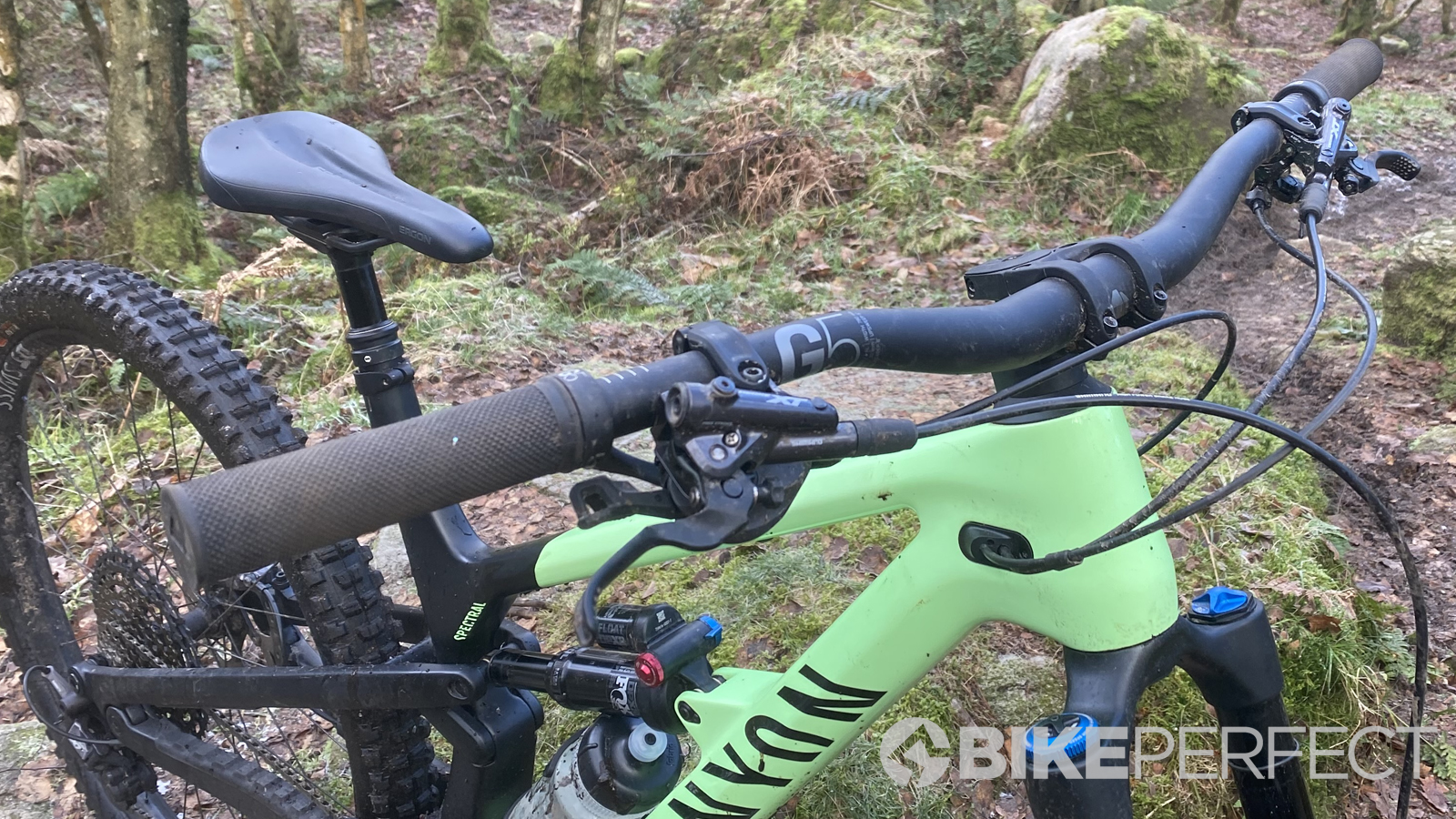
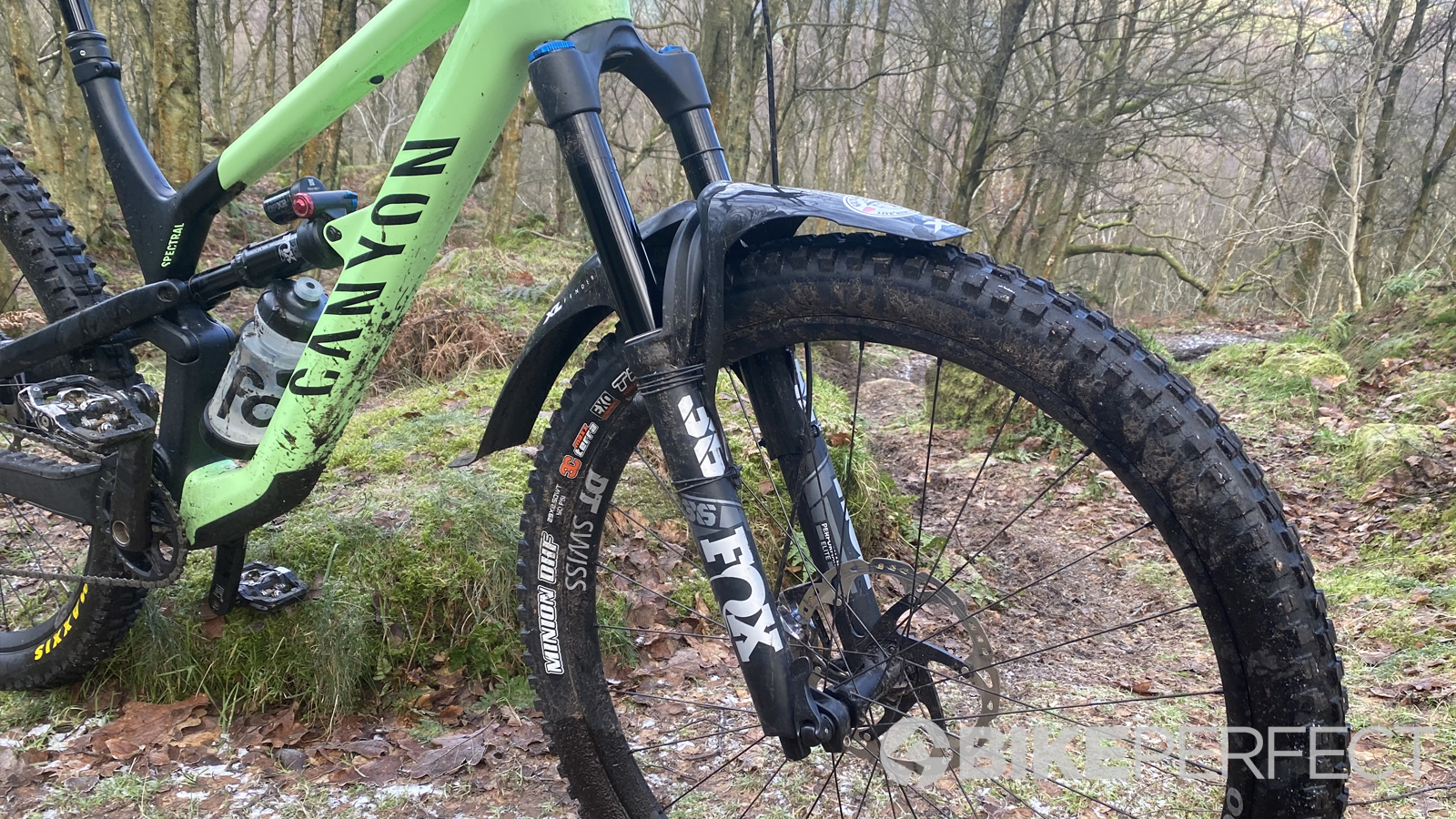
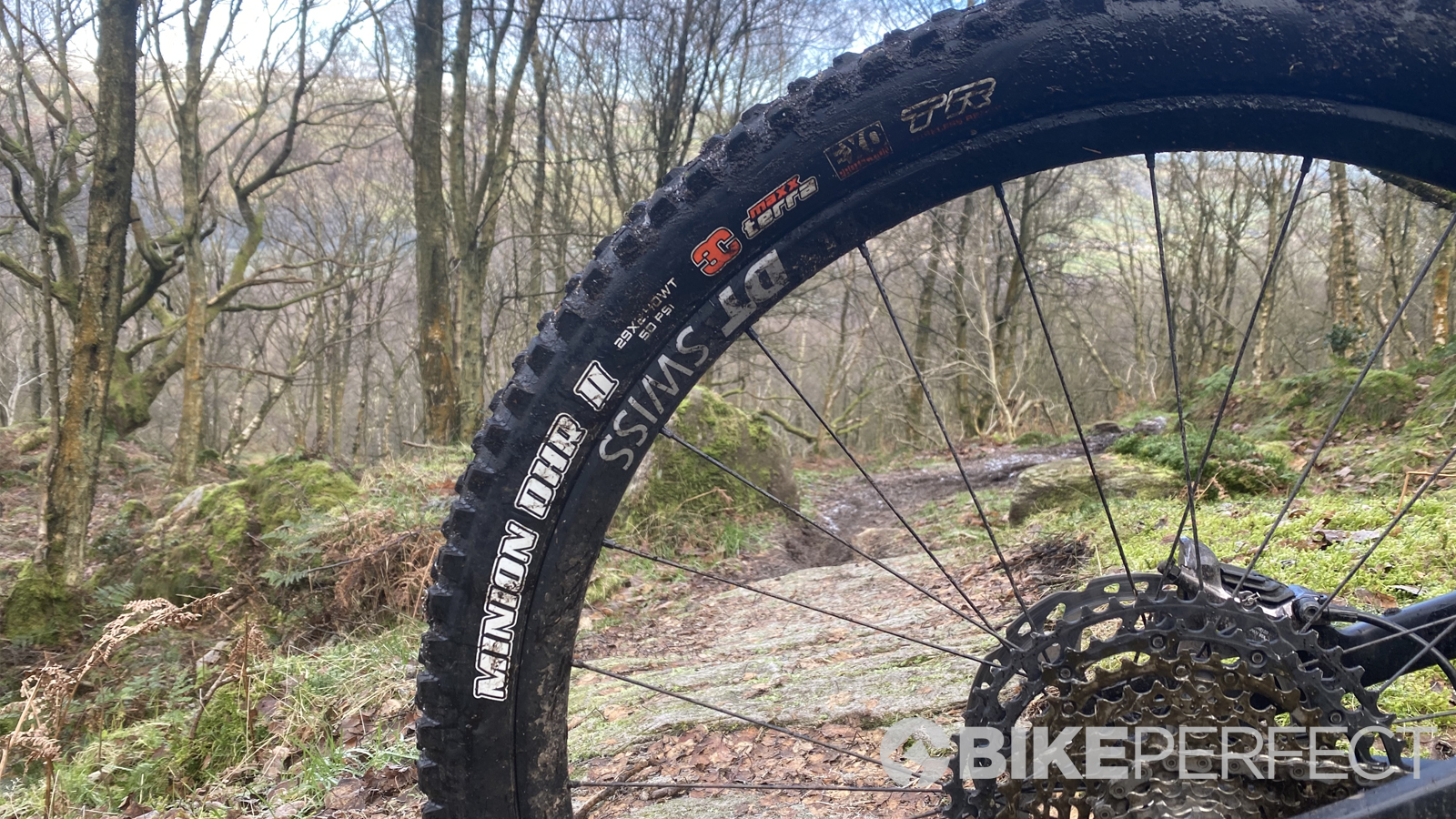
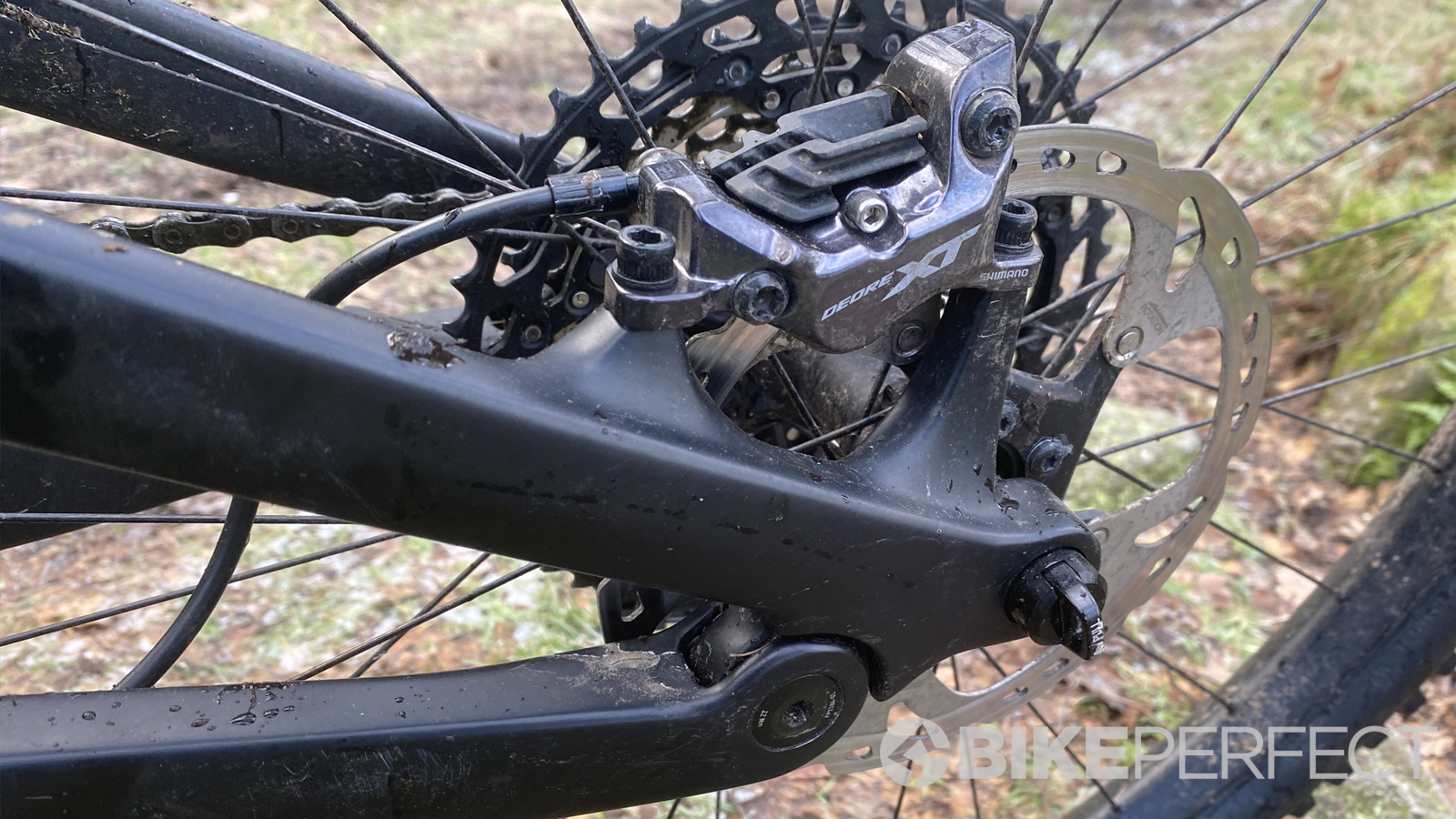
- Best mountain bike wheels: the best MTB wheels reviewed
- Best mountain bike tires: all the top mountain bike tires reviewed
Ride, handling and performance
While the price is always a big draw, Canyon has been competing with the most expensive brands on performance and quality since the start. Canyon is also a master of creating bikes so sorted that you don’t realize just how good they are at first and it took us a couple of rides to realize what a truly outstanding all-rounder the Spectral 29 is.
A prime example of that is while the head angle and bottom-bracket height are properly radical even by enduro, let alone trail, standards the bike felt totally natural from the first ride. Even when we’d just jumped off shorter, steeper XC/Trail machines we settled back into the Spectral without stumbling corners or falling off the outside of turns. Even on steep, technical climbs, the seat angle is enough to stop the front wheel from flopping and falling. There’s just enough bite through the suspension to give you something to push against and enough feedback to keep the DHR tire gripped even on snow and ice. It doesn’t jack up enough to stop it rolling up and over lumps and faces either so grip is consistent whether you’re grunting out of the saddle or sat and spinning. If you find the open setting too soft for road/fire road sections the climb mode on the shock is properly firm for locking out the rear too. Equally, if you find the low ride height has you tapping cranks on ruts and rocks you can flip the shock chip and lift it for more clearance.
The weight of the more burly CF8 kit does cut into acceleration and climbing enthusiasm though and the DHR tire is noticeably draggy on smooth surfaces. That makes the lighter RockShox bikes with faster rear rubber the Spectrals to choose if summiting speed is really important to you.
If you’re more into charging flat out fast and/or techy descents the CF8 is awesome. The Performance Elite Fox 36 gets a floating axle to remove side load from the legs so they can track freely, as well as pressure release valves for really extended or repeated rowdy descents. The GRIP2 damper is brilliant too and open enough that mortal riders can now use the adjusters to tune compression (we added extra-low speed for the steepest trails) rather than having to run them full open and still finding it tappy. The natural ramp of the spring means a well-controlled mid-stroke for driving turns and end stroke progression keeps the nose up in all but the nastiest moments.
The Fox DPX2 shock was transformed in its last overhaul and the 60mm stroke and medium rebound and compression tune sync superbly with Canyon’s proven ‘Triple phase’ kinematic. A 0.4mm volume spacer means there’s scope for ramping the final bit of travel up and down but we found it matched the front fork perfectly as stock, saving the deepest travel for when we really needed it, but with no slaps or chokes even on boulder runs. As a result, while regular rock runners might want a rim-protecting insert or EXO+ tyre carcass on the back, we never felt overly vulnerable without one. The frame always feels quiet and damped rather than sharp and edgy too and even the thinner bar and stem are kinder and smoother on your senses and conform better to the trail for traction than an oversized cockpit on a totally rigid chassis. Even the rattle of the finned rear brake pads didn’t seem as intrusive as it has on other bikes, and that’s a cheap swap-out solution anyway.
Add in that low, long scything geometry and the Spectral is incredibly planted, calm and stable even in weather and trail conditions that should have your eyes on your lenses and your dinner in your shorts. While the front end feels utterly planted the back end has real pep and pop in an almost mullet (27.5in wheel) way. That means if the trail tightens, flattens or suddenly gets trials techy the back end flicks, kicks and corrects almost automatically to make you feel like the rider you want to be, not the one you normally are.

Verdict
Perversely, that control, calmness and confidence overload is why the Spectral was a bit of a slow burner for us. Because it screens out the rattles and blur that you normally define speed with, glues its tires to the ground through turns or over crux moves on climbs, and sucks the sting out of the trail through bars, wheels and frame it basically dials down the drama in every situation. It was only when we realized we hadn’t touched that big 203mm rotor but just sailed over the gap drop we’ve never done before, hit the ‘shredders’ double off to the left with a giddy cackle not a crackle of nerves and finished the run moto drifting foot up through sloppy turns with inside ankle brushing the front axle that the penny really dropped. While it does feel remarkably smooth and calm off the top and it’s perfectly happy to cruise, the core of the bike is an impeccably balanced, firmly supportive and accurate tracking technical trail and DH weapon. One that increasingly comes to life, popping, drifting, sending and playing the harder you push it.
From that point on it was pretty much open season teaching any trail that normally terrified us a lesson in Canyon domination. While the package weight meant climbs were never a gift, the pedaling poise and tenacious traction meant that we regularly left other sharper feeling bikes pushing as we clawed back up for another run, or hit a sudden steep tech section on a roller-coaster trail. Our more XC/Trail oriented testers have been left desperate to try the CF9 to see how good this bike feels with a significant diet under its belt, but the split personality options and outstanding pricing are just further pluses for the Spectral family.
Tech Specs: Canyon Spectral 29 CF8.0
- Discipline: Trail / Enduro
- Price: £4,405.98 (including box and shipping)
- Head angle: 63.5-degrees
- Seat angle: 76.5-degrees
- Frame material: CF Carbon
- Size: S, M, L (tested), XL
- Weight: 14.4kg
- Wheel size: 29-inch
- Suspension (front/rear): Fox 36 Performance Elite 160mm travel, 44mm offset/Fox DPX2 Performance Elite 150mm travel.
- Components: Shimano XT 10-51T 12-speed gearing, I-Spec EV shifter and 32T, 170mm arm chainset. Shimano XT 4 piston brakes with 203/180mm rotors. Maxxis Minion DHF MaxTerra EXO 29x2.5in front and Maxxis Minion DHR MaxTerra EXO 29x2.4in rear on DT Swiss XM1700 wheels. Canyon G5 780x31.8mm bar and 40x31.8mm stem, Iridium 150mm dropper post, Ergon SM10 Enduro Comp saddle.
Test conditions
- Temperature: Minus 2 to 12 degrees
- Surface: Man-made red and black trail center runs, moorland singletrack and old-skool DH race tracks.

Guy Kesteven has been working on Bike Perfect since its launch in 2019. He started writing and testing for bike mags in 1996. Since then he’s written several million words about several thousand test bikes and a ridiculous amount of riding gear. He’s also penned a handful of bike-related books and he reviews MTBs over on YouTube.
Current rides: Cervelo ZFS-5, Specialized Chisel, custom Nicolai enduro tandem, Landescape/Swallow custom gravel tandem
Height: 180cm
Weight: 69kg

